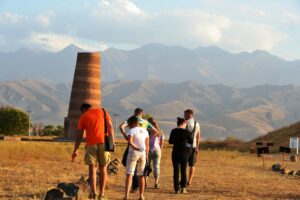Barskaun (Barskoon), a settlement. It is located near the mouth of the Barskaun river, on its right bank. The settlement consists of central ruins (citadel and shahristan) and the territory surrounded by a long wall. Its total area is 8-9 km square. It is identified with the ancient city. Barshan mentioned in written sources IX – XIII centuries. The settlement was discovered by D.F. Vinnik in 1959. Excavations uncovered the remains of rooms, utility pits, collected objects of clay and stone. The material is characteristic of the VIII-XII centuries. About 20 small settlements of X-XII centuries are preserved around the settlement.
Medieval Arabian geographer Gardizi cites a legend about the foundation of Barshan. After Alexander the Great conquered the Persian kingdom in 334 – 329 B.C., he took the noble families as hostages in order to prevent any possible rebellion. Under the circumstances, he was forced to abandon the noble Persians on the shore of Issyk Kul. The sons of Persian nobles, losing hope of returning home, rebuilt the town in their own style, and gave the area the name Barshan. Painters decorated the houses with polychrome multilayer panels similar to those of Sogdia, Ustushan and Tocharistan. Part of the town soon found itself under water, and the other part remained on the elevated plateau of the lake.
To the south-east of Barskaun village, in the Kok-Oy area, a treasure was found containing about 120 stamped copper plaques of 12 kinds, scraps of sheet metal, bowls, and others. The plaques feature zoomorphic images and various forms of geometric and plant ornaments (including the “tree of life” plot). Stylistically, the plaques of the Barskaun hoard are the closest to similar gold plaques from the Issyk barrow, which served as clothing ornaments. The Barskaun treasure allows us to talk about local production of these items. It is dated V-III centuries B.C. It is stored in the funds of the Institute of History of the National Academy of Sciences of Kyrgyzstan.
Aalam Ordo
Aalam Ordo cultural and ethnographic center. It is located 8 km east of Kadzhi-Sai, the



